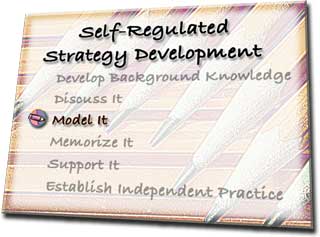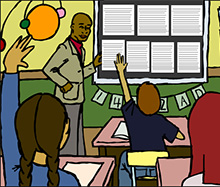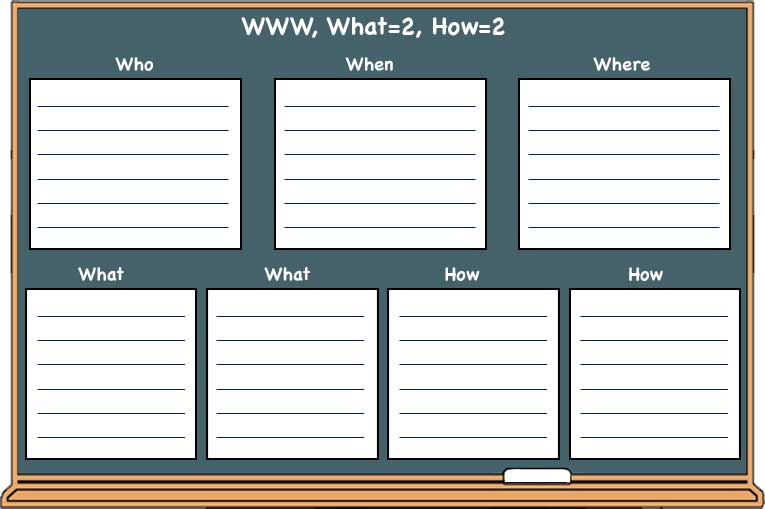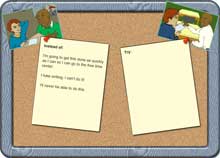What procedures might Ms. Lin suggest?
Page 6: Model It
 Mr. Carter recalls that the third instructional stage—model the strategy—is one of the most critical stages of SRSD. He understands the purpose of modeling is to:
Mr. Carter recalls that the third instructional stage—model the strategy—is one of the most critical stages of SRSD. He understands the purpose of modeling is to:
- Expose his students to the thought processes used by skilled learners
- Show his students how to perform the steps in a strategy
- Demonstrate to his students the reasons the steps in a strategy are necessary
To do all of this, Mr. Carter uses a think-aloud process in which he verbalizes his thoughts as he demonstrates the writing strategy. A good think-aloud process will give Mr. Carter’s students the answers to the following questions:
- What am I being asked to do?
- What strategies do I know that can help me?
- What do I need to do first?
- Am I using all my strategy steps?
- Have I checked my work?
- Have I met all my goals?
 Mr. Carter remembers Ms. Lin’s important advice: How well he models the new strategy can determine how well his students are able to apply it. He should take care not to skip any steps of the writing strategy during his think aloud. Ms. Lin has explained that just going through the steps is not sufficient, particularly for his students with learning disabilities. Indeed, Mr. Carter might find it necessary to model the writing strategy several times. Click to review a sample graphic organizer Mr. Carter will use to model the writing strategy.
Mr. Carter remembers Ms. Lin’s important advice: How well he models the new strategy can determine how well his students are able to apply it. He should take care not to skip any steps of the writing strategy during his think aloud. Ms. Lin has explained that just going through the steps is not sufficient, particularly for his students with learning disabilities. Indeed, Mr. Carter might find it necessary to model the writing strategy several times. Click to review a sample graphic organizer Mr. Carter will use to model the writing strategy.
Sample Graphic Organizer

(Adapted from Powerful Writing Strategies For All Students, by K. R. Harris, S. Graham, L. Mason, and B. Friedlander, 2008, p. 120.)
(Close this panel)
While Mr. Carter models the steps for the writing strategy, he also models another of the self-regulation strategies by showing his students how to use self-statements. He explains to his students that positive self-statements can help them to remain motivated and are a reminder that working hard will help them to achieve their goals. Because negative self-statements interfere with writing, Mr. Carter models how to respond to negative thoughts with positive self-talk. He asks his students to come up with positive self-statements that they can use to help meet their writing goals.
Activity

Some of Mr. Carter’s students made negative statements about writing. Help turn their negative statements into positive ones. Click here or on the bulletin board icon to get started.
Listen to Karen Harris discuss the importance of self-talk (time: 1:25).

Karen Harris, PhD
Division of Educational Leadership and Innovation
Arizona State University, Tempe, Arizona
Transcript: Karen Harris, PhD
The teacher, however, must model not only the use of the writing strategy but the teacher must clearly model the use of all of the self-regulation procedures that have now been discussed with students or that will come into play after modeling has been done. This teacher also has to model handling difficulty, handling frustration, wanting to quit, because these are the things the teacher knows that the students in that classroom will deal with. For example, if I have a student who has low tolerance for frustration, I am definitely going to incorporate into my modeling some statements like, “I can do this if I try. Just calm down and think.” If I have a student who really dislikes writing, I’m going to model something like, ” I really don’t feel like doing this, but it’s important, and I have a trick. I know I can do this.”
These students come to us all too good at self-punishment. In fact, they often begin writing task with statements like, “I’m no good at writing,” “I hate writing,” “I don’t like to do this,” “I wish I didn’t have to do this.” We discuss with students how that sort of talk to themselves, that thinking in their head, how they feel about the task, their dislike for the task, how it gets in their way of performing. If you’re starting out with that negative set of self-statements and affect, it’s going to be much harder to do this task.
Click on the movie below to view a teacher modeling the WWW, What=2, How=2 strategy for her students (time: 2:20).
Transcript: Model The Strategy
Teacher: Okay, so today I’m going to share with you how I write, ’cause sometimes I have trouble writing. And I’m going to show you how I use my tricks. So I have this picture here, and now I have to think, “Hhhhmmm. What am I going to write a story about? What do I do first? This is hard. I know! I’ll use POW.”
So first I have to…What’s “P”? I know: “Pick my idea.” I’m going to pick my idea. Okay, so he’s looking at a magnifying glass. It’s kind of a silly picture. I really don’t like it. Okay, keep my mind free, and I can think of a good idea. I think my idea’s going to be, he’s going on a big adventure. He’s searching for a treasure. That’s what my idea is going to be. So I’m doing POW, okay? So I picked my idea. He’s going on a treasure hunt. All right, that’s done.
So next I have to “Organize my notes.” Writing is so tough. All right, what do I do to organize my notes? That’s right, I learned a trick. WWW, What=2, How=2. So I have this. This is my graphic organizer. This will help me remember my parts. So WWW. “Who?” Oh, I don’t know that one. I can skip that one. “When?” He looks kind of modern, but he has a canteen and a magnifying glass. I’m going to say, like, 1903. Okay. “Where?” Where would somebody go on a treasure hunt? Um, I have no idea. Who does treasure hunts anymore? Okay, keep my mind free. I can do this. Where? Ooh, the desert in Africa. That’ll be good. I like that idea! “Desert.” “Africa.” Okay.